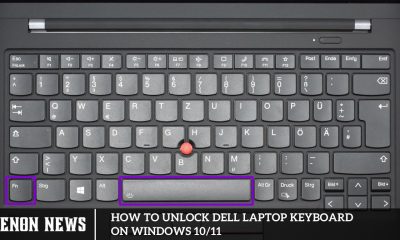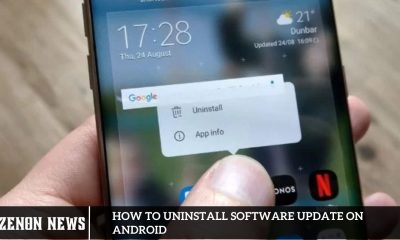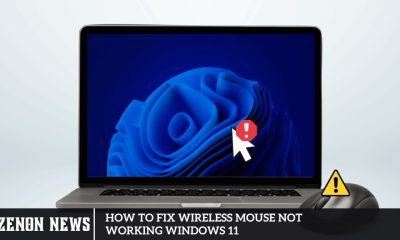How To
How to See Wi-Fi Password on Android Without QR Code

Accessing your Android device’s wifi password can be invaluable for connecting additional devices or sharing the password with friends. However, Android typically doesn’t display passwords directly without a QR code. Nonetheless, alternative methods exist for viewing wifi passwords on Android devices without needing a QR code.
Where staying connected is paramount, forgetting a Wi-Fi password can be a significant inconvenience. But fear not! Android devices offer various methods to retrieve saved Wi-Fi passwords without relying on QR codes. This comprehensive guide will delve into the steps to uncover your Wi-Fi password effortlessly.
Why Retrieve wifi Password Without QR Code?
Understanding the significance of retrieving wifi passwords without QR codes is crucial. While QR code scanning might be convenient, not all routers support this feature. Hence, having alternative methods at your disposal ensures seamless access to your network.
Viewing wifi Password on Android Without QR Code: A Guide
Below are four techniques for accessing saved wifi passwords on Android devices without requiring QR codes or root access.
Utilize the WPS Push Button
Many wifi routers have a WPS (Protected Setup) push button, enabling devices to connect without password entry. You can leverage this feature to retrieve the wifi password on your Android device.
- Navigate to the wifi settings on your Android device and ensure wifi is enabled.
- Press and hold the WPS button on your router for a few seconds until it begins blinking, indicating activation of WPS pairing mode.
- Quickly return to your Android device’s wifi settings. A notification should appear indicating the availability of a WPS connection.
- Tap the notification, and your device will automatically connect to the wifi network.
- The wifi password will now be visible in the network details.
One drawback of this method is its reliance on physical proximity to press the WPS button on the router. However, it offers a straightforward way to access the password without additional apps or root access.
Is It Possible to View wifi Passwords on Android Without Root Access?
Discovering Saved wifi Passwords on Android without Root
Unlocking the ability to view saved wifi passwords on Android devices without root access opens up user possibilities. This article delves into this topic, offering efficient methods to access all wifi passwords stored on your phone with minimal effort.
Author: Joy Taylor
Last Updated: November 22, 2022
DroidKit – wifi Password Display without Root 2022 APK
DroidKit provides wifi password visibility without requiring root access to Android phones, including Samsung devices. Additionally, it facilitates password extraction to another phone. DroidKit is compatible with Android 5.0 and higher. Detailed instructions are provided below.
Free Download
Wifi services typically safeguard access with passwords. However, once you connect with your Android phone, the password is stored on the device, enabling automatic connection in the future. Regrettably, users cannot access these saved passwords without rooting their phones, a practice that should be avoided whenever possible.
Hence, if you aim to retrieve a password for another device, this article furnishes comprehensive guidance on viewing wifi passwords on Android without root access.
You can also refer to our guide on accessing Facebook passwords saved on Android phones.
Can wifi Passwords be Viewed on Android without Root Access?
Discovering and viewing wifi passwords on your phone without root access is possible, which is why this article is available online.
As mentioned, wifi passwords are stored locally on the device for a convenient network connection. However, manually retrieving these passwords proves futile, as they are housed in inaccessible directories without root privileges. The password file can be located at data/misc/wifi on a rooted Android device. However, this solution is impractical, primarily for security reasons.
Alternatively, wifi passwords may be saved in the cloud, as most Android phones routinely sync with corresponding Google accounts. Should you wish to transfer passwords to another device, log in to your Google account on that device, and all pertinent data should synchronize automatically. This method exemplifies how wifi passwords can be retrieved on Android without root access. Continue reading for additional methods to obtain wifi passwords without root access.
Utilize an Android File Manager Application
Specific Android file manager applications offer access to system files without requiring root permissions. You can utilize these apps to locate the wpa_supplicant.conf file containing wifi passwords.
- Download and install a file manager app from the Play Store that supports accessing system files without root.
- Options include X-plore File Manager and FX File Explorer.
- Open the installed app and grant all requested permissions.
- Navigate to the /data/misc/wifi/ directory within the app.
- Locate and open the wpa_supplicant.conf file.
This file contains the wifi SSID (network name) and its corresponding password in plain text. The password is listed next to the psk parameter for each network.
It’s worth noting that this method may only be compatible with some devices, as some may still restrict access to system files. However, it offers password retrieval without additional apps on specific devices.
Utilize an Android wifi Password Application.
You can use specialized apps tailored to reveal saved wifi passwords on Android by accessing system files without root access.
- Download and install a wifi password viewer app from the Play Store. Reliable options include wifi
- Passwords, wifi Password Viewer, and wifi Password Revealer.
- Open the installed app and ensure you grant all requested permissions.
- The app automatically scans your device and displays passwords for saved wifi networks.
While the passwords may be partially obscured for security purposes, they are still visible and can be copied. This method is dependable on most Android devices running version 5.0 or higher.
Retrieve Passwords from Google Account Backup
If your Android device is linked to a Google account with backup functionality enabled, you can retrieve saved wifi passwords by extracting backup data.
- Install the free DroidKit software on your Windows or Mac computer.
- Launch DroidKit and navigate to “Data Extractor,” then select “From Google Account.”
- Sign in to your Google account when prompted.
- Choose your device backup and click “Wifi” from the left menu.
- Saved wifi names and passwords will now be displayed and can be exported.
This method offers a reliable means of accessing wifi credentials stored in your Google account backup. Just ensure that backups are activated on your Android device beforehand.
How to View wifi Password on Android Phone Using File Manager Applications
Another approach entails utilizing file manager applications to access system files containing wifi passwords.
- If you don’t already have one, install a file manager app from the Google Play Store.
- Utilize the file manager to navigate to the “data/misc/wifi” directory or a comparable location on your device.
- Locate and open a file named “wpa_supplicant.conf” or “wpa_supplicant.conf.bak” using a text editor.
Frequently Ask Questions
Can I view my wifi password on Android without using a QR code?
Absolutely! Android devices offer multiple methods to retrieve your wifi password without relying on QR codes.
What is the simplest method to see my wifi password on Android?
One of the simplest methods is to access your device’s wifi settings, locate the saved network, and reveal the password from within the network details.
Are there any reliable third-party apps available to recover wifi passwords?
Yes, several reputable wifi password recovery apps are available on the Google Play Store. Choose one with positive reviews and ensure it has the necessary permissions to access your device’s wifi settings.
Is it safe to use third-party apps to retrieve wifi passwords?
If you download apps from trusted sources and verify their permissions, using third-party apps for Wi-Fiwifi password recovery is generally safe. However, be cautious of apps with questionable reviews or excessive permissions.
Can I access my wifi router’s settings to view the password?
Yes, if you can access your wifi router’s settings, you can log in via a web browser using the router’s IP address and view or change the wifi password.
Will I know my router’s username and password so I can access its settings?
You must enter your router’s username and password to access its settings. If you still need to change these from the default, you can find them in your router’s manual or by searching online for the default credentials.
Conclusion
With these methods at your disposal, retrieving your wifi password on Android devices becomes hassle-free. Whether you prefer the convenience of built-in settings, the flexibility of third-party apps, or the direct access provided by router settings, you’re equipped with the tools to stay connected seamlessly. You will no longer fret over forgotten wifi passwords—follow these steps and easily reclaim access to your network. Stay connected, stay empowered!
How To
How To Fix CPU Fan Not Spinning [Tested Methods]
![How To Fix CPU Fan Not Spinning [Tested Methods]](https://zenonnews.com/wp-content/uploads/2024/05/How-To-Fix-CPU-Fan-Not-Spinning-Tested-Methods.jpg)
Many users encounter the problem of a non-spinning CPU fan. This can be attributed to various factors, including dust accumulation, worn-out bearings, or incorrect BIOS settings. Fortunately, several solutions exist to address this problem, such as cleaning and lubricating the fans or resetting the BIOS.
Discovering that your CPU fan is not spinning can be a daunting experience for any computer user. The CPU fan is a critical component responsible for cooling down the processor and maintaining optimal operating temperatures within your system. When it fails to spin, it not only jeopardizes your computer’s performance but also poses a risk of overheating and potential damage to sensitive components.
Lubricating the Bearings
To ensure smooth operation and prevent rust and wear, it’s essential to lubricate your bearings periodically. Without proper lubrication, bearings can become rusty and eventually stop spinning. Regularly adding oil or a suitable lubricant to your fan’s bearings will improve performance and extend your fan’s lifespan.
“Diagnostic Steps for Resolving CPU Fan Issues”
The issue may be your fan, motherboard, or power supply unit. Below are methods to pinpoint the source of the problem:
- Test Fan Headers: Connect your fan to a different header on your motherboard, such as the PSU, case/chassis, or GPU fan header. For laptop users, testing on another computer is necessary. If the fan spins, the issue may lie with the motherboard or power supply unit.
- Swap Fans: Use a known working fan and plug it into your motherboard. If it spins, the problem likely lies with your original fan.
- Voltage Test: If you have a multimeter, test the voltage across the red and black terminals. It should read 3-5V or 12V. Deviations suggest potential issues with the motherboard or PSU.
- System Diagnostic Tools: Most computers feature built-in diagnostic tools, which include testing the CPU fan. Shut down your laptop, power it on, and immediately press F12 to access the boot options. Select the Diagnostics option, and let the system run tests on all detected devices. After completion, select the fan as a specific device for testing. Any error messages, such as “Fan-The [Processor Fan] failed to respond correctly. Error code 2000-0511. Validation 13133,” indicate a malfunctioning cooling system that requires replacement.
While these solutions offer a starting point, their hardware-related issues can become costly. Therefore, we recommend starting with the less expensive methods outlined above.
“Repairing or Replacing Your Power Supply Unit: A Guide”
“When encountering issues with a non-spinning fan, it’s crucial to consider the power supply unit as a potential culprit. Before replacing more costly components like the motherboard or CPU, attempting to replace the power supply unit can often yield a resolution.
This approach proves particularly effective if your computer emits beeping sounds or experiences sudden shutdowns, which indicates a power supply malfunction.
However, it’s essential to exercise caution and seek assistance from a qualified specialist when addressing such technical issues. Given the complexity involved, professional guidance ensures proper diagnosis and resolution while minimizing the risk of further complications.”
Understanding the Importance of CPU Fan Functionality:
Before delving into troubleshooting methods, it’s crucial to grasp why the CPU fan plays a pivotal role in your system’s health. The CPU generates substantial heat during operation, and the fan’s primary function is to dissipate this heat, preventing overheating and potential damage to the processor.
Here’s a step-by-step guide to lubricate your CPU fan bearings:
- Detach Your Motherboard: Open your PC case and remove the motherboard.
- Remove Fan Power Cable: Unplug the CPU fan’s power cable from the motherboard.
- Unscrew The Fan: Locate the four latches at each fan corner. Use a screwdriver to turn them in the direction indicated.
- Loosen The Latches: Lift each latch until it pops up and becomes loose.
- Remove The Fan: Take out the fan and apply oil to its bearings.
- Reconnect The Fan: Reattach the fan by reversing the above steps.
Common Causes of CPU Fan Not Spinning:
Several factors can contribute to a CPU fan refusing to spin. These include power supply issues, dirt or debris obstructing the fan’s movement, outdated or faulty drivers, mechanical failures in the fan motor, or incorrect fan settings in the system BIOS.
“Performing Maintenance on the CPU Fan: Cleaning Procedures“
“If your computer’s CPU fan is obstructed by dust, it could cause the CPU fan not to spin. Cleaning the CPU fan might resolve this issue, but it’s a delicate task that requires expertise. To avoid inadvertently damaging your computer, it’s advisable to entrust the cleaning process to a professional computer repair service.
A skilled technician can thoroughly clean the CPU fan and inspect for any wires or debris that may obstruct its movement, potentially resolving the issue of the fan not spinning.”
Method 1: Check Power Supply and Connections:
Start troubleshooting by ensuring the CPU fan receives power from the motherboard. Check the fan’s power cable and ensure it’s securely connected to the appropriate header on the motherboard. Additionally, inspect the power supply unit (PSU) to ensure it’s functioning correctly and providing adequate power to the system.
Replacing Your Power Supply Unit (PSU)
A malfunctioning power supply unit (PSU) can cause your CPU fans to stop spinning. Incorrect voltage supply from a faulty PSU can also damage your components. If you notice beeping sounds from the PSU, or if other elements besides the fan malfunction or shut down unexpectedly, consider replacing the PSU to see if it resolves the issue.
Method 2: Inspect and Clean the CPU Fan:
Dirt, dust, and debris can accumulate on the CPU fan over time, hindering its ability to spin freely. Carefully remove the fan from the heatsink and clean it using compressed air or a soft brush. Be sure to clean the heatsink and surrounding components to prevent airflow obstructions.
Method 3: Update or Replace Fan Drivers:
Outdated or corrupted fan drivers can cause issues with fan operation. Check the manufacturer’s website for updated drivers and install them accordingly. If updating the drivers doesn’t resolve the issue, consider reinstalling or replacing the fan drivers altogether.
“The Importance of Cooling Systems: Understanding Their Significance”
“Cooling is vital in ensuring optimal performance and preventing overheating in machines. This is typically achieved through various cooling mechanisms such as ventilation systems, coolants, and, most commonly, cooling fans. Therefore, when a fan fails to run, it becomes a cause for concern.
Cooling fans, such as those found in the PSU, CPU, case/chassis, and GPU, are essential components in a computer system. Users have reported instances where the failure of the CPU fan leads to overheating, resulting in system crashes or the dreaded Blue Screen of Death (BSOD). This occurs because the thermal monitoring system detects excessive heat and triggers a shutdown to prevent damage. Consequently, during the boot process, the system may encounter a fan error, causing it to remain non-functional for a period.
This article addresses such issues and provides troubleshooting steps for scenarios where the CPU fan is not functioning. It will offer practical solutions to resolve the problem and ensure the system’s smooth operation.“
Method 4: Test and Replace the Fan Motor:
The motor may have failed if the fan refuses to spin after following the above steps. Use a multimeter to test the continuity of the motor’s wiring and determine if it’s receiving power. If the motor is faulty, replace it with a compatible replacement.
Method 5: Monitor System Temperature and Adjust Fan Settings:
Use monitoring software to monitor your system’s temperature and ensure it remains within safe limits. Adjust fan settings in the system BIOS to increase fan speed or enable automatic fan control based on temperature readings.
Conclusion
Troubleshooting a CPU fan that’s not spinning involves a systematic approach to identify and address potential issues. By following the tested methods outlined in this guide, including checking power connections, cleaning dust and debris, verifying BIOS settings, testing the fan on another system, replacing faulty fans, ensuring correct installation, and monitoring with software tools, you can effectively diagnose and resolve the problem. However, if the fan continues to malfunction despite these efforts, seeking professional assistance may be necessary to diagnose and repair any underlying hardware issues. Remember to prioritize safety by powering off and unplugging your PC before performing any maintenance or repairs. With patience and persistence, you can ensure proper cooling for your CPU and maintain optimal performance and longevity for your system.
How To
How To Clear Browser’s Cache? [PC And Phone]
![How To Clear Browser’s Cache [PC And Phone]](https://zenonnews.com/wp-content/uploads/2024/05/How-To-Clear-Browsers-Cache-PC-And-Phone.jpg)
Browsing the internet has become an integral part of our daily lives, whether on our PCs or smartphones. However, over time, our browsers accumulate a plethora of data from the websites we visit, stored in a cache. While this cache enhances loading times by preloading data such as images and stylesheets, it can also lead to slow performance and outdated content. Therefore, understanding how to clear your browser’s cache is crucial for maintaining optimal browsing performance and ensuring access to the most up-to-date content. This guide will explore step-by-step instructions for clearing the cache on both PC and mobile devices, empowering you to streamline your browsing experience effortlessly.
The cache in your browser stores data from websites you visit, aiding in faster loading times upon revisits. Learning to clear your cache is essential for optimizing your browsing experience.
For Desktop Devices
The process for clearing the cache on various PC browsers, such as Chrome, Edge, Opera, or Mozilla Firefox, is quite similar. However, the method differs significantly for the Safari browser.
Why Should You Clear Your Browser’s Cache?
Benefits of Clearing Cache
- Improves Performance: Over time, cached data can slow down your browser. Clearing it can enhance speed and responsiveness.
- Fixes Loading Issues: Resolves issues with pages not loading correctly or displaying outdated content.
- Frees Up Space: Removes unnecessary data, freeing up storage space on your device.
- Enhances Privacy: Erases stored passwords, cookies, and other sensitive information, enhancing your privacy.
Chrome by Google
Accessing Google Chrome Settings and Clearing Cache:
- Open Chrome: Launch the web browser on your device.
- Navigate to Settings: Locate and click on the three-dot (⋮) symbol at the browser window’s top-right corner, then select “Settings.”
- Access Clear Data Section: On the left sidebar, click “Privacy and Security.”
- Precise Browsing Data: Scroll down for the “Clear browsing data” option.
Clearing Cache:
- Select Basic Settings: Within the “Clear browsing data” menu, choose the “Basic” section.
- Choose Cached Images and Files: Check the box next to “Cached images and files.”
- Set Time Range: Ensure the time range is set to “All time” to clear the entire cache.
- Precise Data: Click “Clear data” to remove the cached images and files from Google Chrome.
How to Clear Cache on PC
Google Chrome
- Open Chrome: Launch Google Chrome on your PC.
- Access Settings: Click on the three-dot menu in the top-right corner and select “Settings”.
- Advanced Options: Scroll down and click on “Advanced” to expand more options.
- Precise Browsing Data: Under the “Privacy and Security” section, click “Clear browsing data.”
- Choose Time Range: Select the time range to clear the cache. To clear everything, choose “All time.”
- Select Data to Clear: Ensure “Cached images and files” is checked. Optionally, you can also select other data types.
- Precise Data: Click “Clear data” to remove the cached files.
The Benefits of Clearing Cache and Cookies
Clearing the cache and cookies from your web browser is a crucial initial step in troubleshooting internet browsing issues. The cache stores data to accelerate page loading times, but it can sometimes cause conflicts when websites are updated, as the cached files may not match the current site code. By clearing the cache and cookies, you ensure that any problems encountered are genuinely due to issues with the website itself rather than inconsistencies from different browsers.
Opera Browser
Accessing Opera Settings:
- Load Opera Homepage: Wait for the Opera homepage to fully load in your browser.
- Access Settings: Click on the Opera logo (O) at the screen’s top left corner, then select “Settings.”
Expanding Clear Browsing Data:
- Navigate to Privacy and Security: In the Settings menu, find and click on “Privacy and Security.”
Deleting Cache:
- Go to Clear Browsing Data: Scroll to the “Clear browsing data” section.
- Choose Basic Settings: Ensure you are on the “Basic” tab.
- Set Time Range: Select “All Time” from the dropdown menu to clear the cache entirely.
- Select Cached Images And Files: Tick the checkbox next to “Cached images and files.”
- Precise Data: Click “Clear data” to delete the cached images and files from Opera.
Microsoft Edge Browser
Accessing Microsoft Edge Settings:
- Navigate to Edge Homepage: Start by visiting the Microsoft Edge homepage.
- Open Menu: Click the three-dot (⋯) icon at the browser window’s top-right corner.
View More Options:
- Hover over the three-dot menu: Look for a small arrowhead at the bottom of the dropdown menu.
- Click on it to reveal additional options.
Accessing Edge Settings:
- Choose Settings: From the expanded menu, select “Settings” to proceed to the next page.
Navigating to Clear Data Section:
- Highlight Privacy, Search, And Services: On the left-hand side of the Settings page, locate and click “Privacy, Search, And Services.”
- Select Clear Browsing Data: In this section, find and click “Clear browsing data.”
- Press “Choose What To Clear” to customize your data-clearing preferences.
Deleting Cache:
- Keep Time Range as All Time: Ensure the time range is set to “All Time.”
- Choose Cached Images And Files: Tick the checkbox next to “Cached images and files.”
- Clear Now: Finally, click “Clear now” to remove the cached images and files from Microsoft Edge.
Mozilla Firefox Browser
Accessing Mozilla Firefox Settings:
- Open Firefox Browser: Launch your Mozilla Firefox browser on your device.
- Select the Hamburger Menu: Click on the three horizontal lines (≡) in the browser window’s upper-right corner.
- Choose Settings: From the dropdown menu, select “Settings.”
Clearing Data:
- Navigate to Clear Data: In the Settings menu, locate and click “Privacy And Security.”
- Click on Clear Data: Within the “Privacy And Security” section, find the “Clear Data” option.
Safari Browser (macOS)
Accessing Safari Preferences:
- Launch Safari: Open Safari browser on your macOS computer.
- Navigate to Preferences: Click on the Safari menu on your top panel, then select “Preferences.”
Modifying Menu Bar:
- Select Advanced: Within the Preferences window, navigate to the “Advanced” tab.
- Check Show Develop Menu: Tick the checkbox next to the “Show Develop menu in the menu bar.”
Emptying Cache:
- Choose Develop: Once the Develop menu appears in the top panel, click on it.
- Select Empty Caches: From the dropdown menu, choose “Empty Caches” to clear the cache in Safari.
Mobile Phone Usage
In sluggish browser performance or challenges with website loading on mobile devices (Android and iOS platforms), I frequently address the issue by clearing the browser cache. This action effectively removes outdated or corrupted cached data, enhancing the browser’s functionality and facilitating the retrieval of the most up-to-date website resources.
Enhancing Browser Performance: Google Chrome
I found it necessary to clear Chrome’s cache due to frequent crashes during regular usage. Both methods outlined in this section proved equally effective and required nearly identical completion times.
Navigating the Web: Via Browser
Locating Google Settings:
- Launch the Chrome browser on your mobile device.
- Tap the Three-Dot (⋮) menu at the screen’s top right corner.
- Choose “Settings.”
Accessing Privacy Settings:
4:Scroll down and locate the “Privacy and Security” section.
5:Tap on it to proceed.
Clearing Cache:
6:Under the “Privacy and Security” section, tap “Clear Browsing Data.”
7:Select “Cached Images and Files.”
8: Ensure the Time Range is set to “All Time.”
9:Tap “Clear Data” to complete the process.
Accessing Phone Settings
Accessing App Settings:
- Access the App Screen on your device.
- Navigate to the phone’s Settings and select “Apps.”
Selecting Chrome:
3:Locate Chrome from the list of installed applications and tap on it.
Accessing Storage Settings:
4:Once in Chrome’s settings, select the “Storage” option from the menu.
Clearing Cache Data:
5:Scroll down and tap “Clear Cache” from the options in the bottom menu.
Safari Browser on iOS
Important Note Before Clearing Cache:
Before clearing the cache on your Safari browser, please be aware that this action will log you out of any websites you are currently signed into. Ensure you have noted down or remembered all your passwords to avoid any inconvenience.
Accessing General Settings:
1:Tap the Settings icon on your App Screen, then navigate to “General.”
Moving to Storage Settings:
2:Scroll down and locate “iPhone Storage.”
Selecting Safari:
3 Among the listed apps, find and select “Safari.”
Accessing Website Data:
4:Choose “Website Data” to view the browser cache and saved sites.
Clearing Browser Data:
5:Finally, press the last option, “Remove All Website Data,” to clear the browser cache.
Frequently Asked Question
Will clearing my browser’s cache delete my saved passwords?
No, clearing your browser’s cache will not delete your saved passwords. However, it will remove temporary files, which may include cached versions of websites and login sessions. Remember your passwords; you may need to log in to websites again.
A browser cache is a temporary storage location on your device where your browser saves copies of web pages, images, and other resources to speed up the loading process when you revisit these sites.
Why should I clear my browser cache?
Clearing your browser cache can resolve issues like slow loading times, display errors, and outdated content. It helps free up space on your device and ensures you view the most current versions of web pages.
conclusion
Clearing your browser’s cache is an essential maintenance task that can enhance your browsing experience by resolving performance issues and ensuring you access the most up-to-date versions of websites. It is straightforward and can be completed in a few minutes, whether you are using a PC or a mobile device.
On a PC, popular browsers like Google Chrome, Mozilla Firefox, Microsoft Edge, and Safari provide easy access to their cache-clearing functions through their settings menus. On mobile devices, including both Android and iOS platforms, the process is similarly accessible via browser or device settings.
How To
How To Vertical Mount Your GPU [Precautions + Steps]

The practice of vertically mounting GPUs has surged in popularity in recent years. Nevertheless, it’s crucial to consider potential pitfalls before undertaking this modification, as failure to do so could damage the component.
We’ll delve into the essential precautions and steps of vertical GPU mounting. Whether you’re a seasoned PC builder or a newcomer to the world of custom rigs, understanding these fundamentals will empower you to execute this modification confidently and effectively. Let’s embark on this journey to unlock the potential of vertical GPU mounting while safeguarding your hardware investment.
Revised Heading: Vertical GPU Mount Bracket
A mounting bracket facilitates the installation of a graphics card in a customized orientation within your PC case. It seamlessly integrates into the expansion slot backplate, eliminating the need for extra space and contributing to an aesthetically pleasing setup. Once the bracket is securely positioned and the GPU is affixed, connect a PCIe riser cable to the bracket and insert it into the motherboard’s PCIe slot.
Crafting a bespoke bracket from materials such as aluminum or acrylic becomes an option when a vertical GPU mounting bracket is not included. While this approach demands some DIY expertise and access to appropriate tools, it presents a cost-effective solution and affords your build a distinctive appearance.
Understanding Vertical GPU Mounting
- Exploring the Rise of Vertical GPU Mounting in PC Building
- Benefits of Vertical GPU Mounting: Aesthetics, Airflow, and Cooling Efficiency
- Factors to Consider Before Opting for Vertical GPU Mounting: Case Compatibility, Clearance, and Thermal Considerations
Mounting GPU Horizontally: Steps and Precautions
Graphics cards are conventionally installed horizontally, featuring the top plate atop, the cooling fan at the bottom, and the shroud enveloping the card. Although this method has stood the test of time, it might offer a less visually striking appearance. Nonetheless, there are numerous advantages to opting for a horizontal installation:
- Enhanced Airflow: By orienting the graphics card horizontally, it is not pressed against the glass panel, facilitating optimal airflow and cooling efficiency. This aids in maintaining ideal temperatures and ensures consistent performance, particularly during demanding tasks or overclocking endeavors.
- Simplified Installation: Horizontal mounting necessitates no additional hardware or cables. Merely insert the card into the PCIe slot on the motherboard, secure it within the case, and you’re all set to proceed.
“Mastering Vertical GPU Mounting: A Step-by-Step Guide”
Having explored various methods for vertical GPU mounting, let’s now delve into the step-by-step process of mounting your graphics card vertically using a mounting bracket:
- Removing the necessary expansion slot backplates from your PC case to accommodate the vertical GPU bracket.
- Next, carefully install the bracket into the designated expansion slots within the case, ensuring a secure fit.
- With the bracket securely in place, gently insert the GPU into the provided slot, aligning it correctly.
- Connect the PCIe riser cable from the bracket to the top x16 PCIe slot on the motherboard, ensuring a snug and secure connection.
- Proceed to connect any required 6-pin or 8-pin power cables to the graphics card, following the same procedure as you would for a horizontally mounted GPU.
- Before closing the case, test the system to ensure the graphics card is properly mounted and all cables are securely connected, verifying everything functions correctly.
- If you’re solely utilizing a riser cable for vertical mounting, ensure beforehand that the cable length is sufficient for your intended placement of the GPU. It should comfortably reach its destination without exerting undue strain on the motherboard’s PCIe slot.
By following these meticulous steps, you can confidently achieve a professionally mounted vertical GPU configuration, which will enhance your PC build’s performance and visual appeal.
Preparing for Vertical GPU Mounting
- Assessing Case Compatibility: Native Support vs. Mounting Kits
- Selecting the Right Mounting Kit: Factors to Consider
- Ensuring Adequate Clearance and Airflow: Optimizing Case Layout and Cable Management
“Comparing Horizontal and Vertical GPU Mounting: Understanding the Distinctions”
Traditionally, graphics cards are placed in computer cases horizontally, facilitating straightforward installation, maintenance, and port accessibility. However, the positioning of the graphics card can significantly impact the system’s cooling dynamics.
The graphics card’s fan typically faces downwards in horizontal mounting, accumulating hot air around the GPU. This can elevate temperatures, adversely affecting performance and longevity and potentially leading to issues like GPU artifacts.
Conversely, vertical GPU mounting offers a promising solution to enhance airflow and cooling efficiency within the system. The graphics card’s fan faces sideways in this configuration, aligning with the case’s side panel. This orientation promotes improved airflow circulation, aiding in the effective dissipation of heat generated by the graphics card.
Precautions and Safety Measures
- Understanding the Risks: Potential Damage to GPU and Other Components
- Following Manufacturer Guidelines: Importance of Proper Installation Techniques
- Handling Components with Care: Avoiding Static Electricity and Physical Damage
Ensure Compatibility of Your Case
Assessing the feasibility of mounting your graphics card vertically is imperative before doing so. While most graphics cards can be vertically mounted, and most motherboards can accommodate a riser cable connection instead of direct mounting, only a few cases support this feature out of the box.
Certain cases are specifically engineered to provide vertical mounting as an option. If yours falls into this category, you’re all set to proceed. However, if your case doesn’t offer native support, you must investigate whether it’s compatible with any available mounting kits. Moreover, ensure that vertical mounting won’t impede your ability to reassemble the side panel.
Whatever case or kit you’re considering, verify that it can adequately support your graphics card, considering its dimensions and weight.
If everything aligns satisfactorily, proceed with your plan. Otherwise, it would help if you explored alternative cases or DIY mounting solutions.
Step-by-Step Installation Guide
- Step 1: Gathering Necessary Tools and Equipment
- Step 2: Removing Side Panels and Accessing PCIe Slots
- Step 3: Installing the Riser Cable and Mounting Bracket
- Step 4: Securing GPU Vertically and Connecting Power Cables
- Step 5: Double-Checking Connections and Ensuring Stability
“Addressing GPU Droop: Strategies for Preventing Graphics Card Sag”
When a GPU is installed without proper support, its weight can cause it to sag within the PCIe slot, posing the risk of eventual disconnection or damage. Vertical mounting essentially eliminates this concern.
Therefore, your case and panel configuration choice is pivotal in deciding whether vertical GPU mounting suits your setup. Before proceeding, it’s also prudent to explore top GPU overclocking software options if you’re aiming to enhance your GPU’s performance.
“Challenges of Vertical GPU Mounting: Addressing Potential Issues”
The primary challenge when opting for vertical GPU mounting is ensuring compatibility with the case. Not all instances or GPUs are designed for vertical installation, often necessitating adjustments or component removal. Verifying sufficient clearance for the GPU’s height within your case is crucial. Additionally, remember that a vertically mounted GPU may obstruct other slots, necessitating a cable for enhanced flexibility.”
Post-Installation Considerations
- Conducting Thermal Testing: Monitoring GPU Temperatures Under Load
- Adjusting Fan Curves and Overclocking Settings: Optimization for Vertical Orientation
- Troubleshooting Common Issues: Addressing Compatibility and Stability Concerns
Diablo 4 Season 4 Commencement Date
Diablo 4 Season 4, known as Loot Reborn, will commence on May 14 at 1 p.m. EDT, 10 a.m. PDT, and 6 p.m. BST, coinciding with the substantial balancing and itemization overhaul Patch 1.4.0. While a new season marks a fresh start for those looking to conquer their seasonal battle pass and reap its rewards, this patch also brings numerous advantages for players in the Eternal Realm.
Expert Tips and Recommendations
- Investing in High-Quality Riser Cables and Mounting Brackets
- Customizing RGB Lighting Effects: Enhancing Aesthetics of Vertical GPU Mounting
- Exploring Alternative Cooling Solutions: Liquid Cooling vs. Air Cooling for Vertical Orientation
Frequently Asked Question
What is vertical GPU mounting, and why should I consider it?
Vertical GPU mounting involves installing your graphics card vertically within your PC case, typically using a mounting bracket. This option is famous for its aesthetic appeal and potential benefits in airflow and cooling.
Do I need any special tools or equipment for vertical GPU mounting?
While essential tools like screwdrivers may be necessary for installation, special equipment such as a mounting bracket and PCIe riser cable are typically required for vertical GPU mounting.
Will vertical GPU mounting affect my graphics card’s performance or lifespan?
Vertical GPU mounting should not significantly impact performance or lifespan when done correctly. However, inadequate cooling or strain on the PCIe slot due to GPU weight may lead to temperature issues or potential damage over time.
Can I revert to horizontal GPU mounting if needed?
Yes, most cases that support vertical GPU mounting also allow for horizontal mounting. Remove the vertical mounting bracket and reinstall the GPU in the traditional horizontal orientation.
Where can I find additional resources or assistance for vertical GPU mounting?
Online forums, community groups, and manufacturer documentation are valuable sources of information and support for vertical GPU mounting. Additionally, consulting with experienced PC builders or seeking professional assistance can provide guidance tailored to your specific setup.
Conclusion
Vertical mounting your GPU can add a sleek and unique aesthetic to your PC build while improving airflow and showcasing your graphics card. However, it’s crucial to approach the process with caution and attention to detail to avoid potential pitfalls.
First and foremost, ensure that your case is compatible with vertical GPU mounting and that you have the necessary hardware, such as a riser cable and compatible PCIe slots. Prioritize safety by carefully following the manufacturer’s instructions and recommendations, as improper installation can damage your GPU or other components.
-

 Windows2 months ago
Windows2 months agoHow to Type pi π symbol on Windows, iOS and Android
-

 Social Media2 months ago
Social Media2 months agoHow to Use Facebook Marketplace Without an Account
-

 How To2 months ago
How To2 months agoHow to Activate USB Debugging on Android Devices
-

 Windows1 month ago
Windows1 month agoHow to Unlock Dell Laptop Keyboard on Windows 10/11
-

 Apps2 months ago
Apps2 months ago12 Best Free Video Editing Apps For Android (2022)
-

 How To1 month ago
How To1 month agoHow to Uninstall Software Update On Android
-

 How To1 month ago
How To1 month agoHow to Convert Picture to Text in Excel or Word
-

 Windows1 month ago
Windows1 month agoHow to Fix Wireless Mouse Not Working Windows 11








![How To Fix CPU Fan Not Spinning [Tested Methods]](https://zenonnews.com/wp-content/uploads/2024/05/How-To-Fix-CPU-Fan-Not-Spinning-Tested-Methods-80x80.jpg)
![How To Clear Browser’s Cache [PC And Phone]](https://zenonnews.com/wp-content/uploads/2024/05/How-To-Clear-Browsers-Cache-PC-And-Phone-80x80.jpg)


